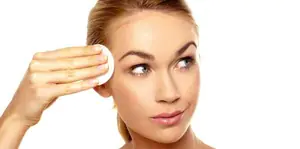
Acne on the temples in adults is a fairly common phenomenon, which many ignore, considering it a normal reaction of the body. But in some cases, a cosmetic defect may indicate the beginning of the development of pathology of internal organs and systems. The causes of acne on the forehead and temples in women and men are varied. Treatment measures should be aimed not only at eliminating external manifestations, but also at combating the predisposing factor.
General predisposing factors
The causes of pimples on the temples can be varied. Until the age of 25, their appearance is considered normal and often does not require special treatment. A rash on the face and temples of a person over 25 years of age often indicates problems with internal organs. Common factors that cause rashes include:
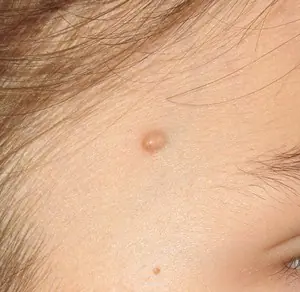
Hereditary predisposition. Plays an important role in the appearance of a cosmetic defect.- Hormonal changes in the body. Most often it causes the appearance of acne, red spots and subcutaneous bumps in women during pregnancy and menstruation.
- Stressful situations that adversely affect the functioning of the body as a whole.
- A large number of dead epidermal cells.
- Steroid drugs cause acne on the temples in men who play sports professionally.
- Traumatic injuries accompanied by a violation of the integrity of the skin and an inflammatory process.
- Professional activities associated with regular human contact with chlorine or products that contain it.
- Some medications can cause rashes.
- Small insects also often become a predisposing factor.
- Failure to comply with personal hygiene rules, abuse of cosmetics, temperature changes.
- Unbalanced diet.
However, the most likely cause is considered to be hyperactivity of the sebaceous glands, which leads to blockage of the skin pores, accumulation of sebum in their cavity and the development of the inflammatory process. Fixing the problem is quite difficult, as is identifying its source.
Diseases of internal organs
Many pathological conditions of internal organs lead to the appearance of a rash on the left and right temples. Most often, doctors suspect the presence of the following diseases:
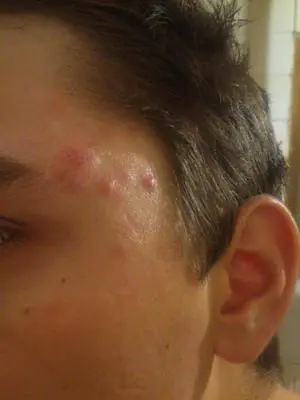
The cause of acne on the temples in men is often diseases of the stomach and intestines, which lead to a decrease in the supply of nutrients and vitamins, which negatively affects the functioning of the sebaceous glands.- Disorders of the urinary system, especially the kidneys, lead to excessive accumulation of toxins and waste products in the body. As a result, the sebaceous glands actively produce sebum. The skin cannot cope with its excess amount and comedones, blackheads, acne, and pimples appear. Such symptoms are accompanied by frequent pain in the lumbar region, swelling associated with the inability of the organ to remove fluid.
- The gallbladder plays an important role in the functioning of the gastrointestinal tract. Failure in its work negatively affects a person’s appearance. Cholecystitis, cholelithiasis, bile duct dyskinesia often cause acne on the temples in women. Associated symptoms are dyspepsia, pain in the right hypochondrium, worsening after eating a large meal, jaundice of the skin and sclera.
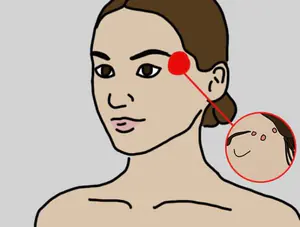
Liver pathologies often lead to the appearance of a rash in the temple area. The patient is also concerned about pain at the site of organ projection, a bitter taste in the mouth, stool disorders, weight loss, lack of appetite, constant fatigue, lethargy, and drowsiness. Such signs indicate serious violations and require immediate contact with a specialist.- Hormonal imbalance in women is accompanied by disruption of the menstrual cycle, the appearance of a large amount of hair on the body and hair loss on the head, and reproductive dysfunction. These manifestations require qualified medical assistance, since you cannot get rid of them on your own.
- Infectious pathologies of the epidermis, for example, demodicosis, also often provoke the appearance of a skin defect. Subcutaneous mites most often live in the area of the cheeks, cheekbones, ears, and forehead. But transferring them to other parts of the body is easy. If the patient has undergone a complete examination, but no diseases of the internal organs are detected, an analysis should be performed for the presence of parasites. A characteristic sign of their presence on the skin are red spots, which over time become purulent pimples that are painful to the touch. Lumps and bumps are often observed. Such rashes are quite difficult to treat.
In recent decades, many scientists have been studying the psychosomatics of acne and have come to the conclusion that any disturbance in the functioning of the central nervous system has a detrimental effect on the condition of the skin. For some people, even a minor disorder can cause a rash that is difficult to treat.
Diagnostic methods
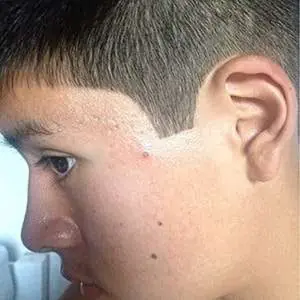
Most people rarely turn to a specialist when rashes appear and solve the problem on their own. But if therapy is ineffective, it is recommended to visit a therapist who will prescribe the necessary examinations.
A mandatory point in the diagnosis will be a consultation with an endocrinologist, gynecologist, as well as a dermatologist and gastroenterologist. After this, it is necessary to conduct a laboratory blood test for general and biochemical analysis. An important point will be the analysis of liver tests.
If a hormonal imbalance is suspected, determination of the level of hormones in the blood is indicated. Many patients are prescribed an ultrasound examination of the abdominal organs. Based on diagnostic data, appropriate treatment is prescribed.
Treatment with salon procedures
The attending physician must understand what pimples on the temples mean and what their location means. The treatment option largely depends on this. Currently, the use of hardware and other techniques in specialized salons is quite common.
Laser resurfacing is considered a popular way to combat cosmetic defects.. During the procedure, problem areas of the epidermis are treated with a special device, it becomes smooth and clean. The method has its contraindications, which should be taken into account before using it.
A gentle and painless method is microdermabrasion. The procedure involves removing dead skin cells, which stimulates intensive renewal processes. As a rule, after several sessions there is a significant improvement.
Chemical peeling is carried out using synthetic and natural acids. During the session, the top layer of skin is completely destroyed; for several days the patient should not go out into open sunlight, strong wind or frost. The method is suitable only for those with a normal type of epidermis, since it is contraindicated for patients with sensitive skin.
The number of procedures is determined by the cosmetologist. It depends on the skin type and the severity of the pathology. To get results, 6-8 sessions are usually enough.
Pharmacy products
Currently, on pharmacy shelves you can find many medicines that are designed to combat cosmetic imperfections. But old and time-tested drugs are also popular:
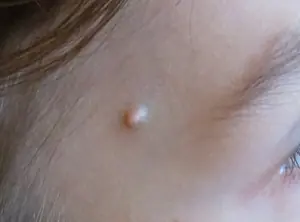
Ichthyol, Sulfur and Zinc ointments are inexpensive products with antiseptic and anti-inflammatory effects. Their use must be coordinated with your doctor, as improper use can harm the skin.- The drug Isotretinoin is prescribed to reduce sebum production. It not only eliminates acne, but also promotes rapid healing. As a rule, after using it there are no marks or scars left from deep blackheads and acne.
- The drug Zinerit has wound-healing, antiseptic and bactericidal properties.
- Erythromycin ointment is a powerful anti-inflammatory agent that quickly and effectively copes with rashes of various etiologies and severity.
- Retinoic ointment, Dimexide, is very popular.
- Antihistamines will help prevent the development of an allergic reaction: Loratadine, Claritin, Citrine, Zodak.
During the therapy period, you should avoid sunbathing, going to the bathhouse and solarium. In some cases, cosmetologists advise not to use decorative cosmetics for several days.
Alternative medicine recipes
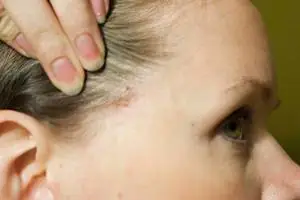
Recipes from traditional healers, which have long been used by humans, will help eliminate rashes and improve the health of the skin. Most often, medicinal herbs are used for this purpose.
Calendula has a cleansing, anti-inflammatory and disinfectant effect. Its use in caring for the epidermis brings amazing results. It is allowed to use pharmaceutical products in the form of ointments and tinctures or prepare a healing decoction yourself. To do this, you need to boil a tablespoon of raw material in a glass of water for 10 minutes, leave to infuse for 30 minutes, and filter. Use the resulting product morning and evening as a lotion and wipe the temple area. Repeat until complete recovery.
Aloe juice gently cares for even very sensitive skin and has an antiseptic and healing effect. It must be used in its pure form. To do this, grind several large leaves and squeeze out the juice using gauze. Morning and evening, wipe your temples and entire face with juice. Repeat therapy for 3 weeks.
For normal and oily skin types, it is allowed to use celandine juice. Since the plant is considered poisonous, it should be diluted with water in a 1:1 ratio and targeted to areas of inflammation. Use no longer than 10 days. It is allowed to repeat after a 2-week break.
Chamomile flowers are considered the best antiseptic and anti-inflammatory remedy for sensitive skin. A decoction based on medicinal herbs is used to wipe the face in the morning and evening, as well as for washing. It’s simple to prepare the composition: separate 20 g of raw materials and boil in 300 ml of water for 20 minutes, leave for 1 hour. Use the filtered product in a convenient way for 4 weeks.
Tea tree oil has long been used by women to relieve dermatological ailments. For treatment, it is necessary to choose only high-quality raw materials. It should be used in its pure form, applied to acne with a cotton swab three times a day. Continue therapy until the rash disappears.
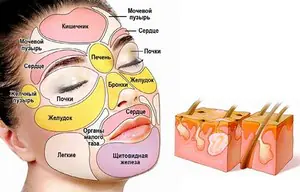
A simple and effective remedy is tar soap. It is used to wash the face. The product has an antiseptic, astringent and drying effect, so those with dry and sensitive skin should refrain from frequent use. As a rule, 2 weeks of morning procedures are enough to permanently cope with the problem.
A clay mask with the addition of 3 tablets of pre-ground aspirin has a good therapeutic effect. You should take a tablespoon of green, white or blue clay, dilute it with a small amount of water until it becomes a paste, and apply it for 20 minutes. Repeat the therapy three times a week and within a month the result will be noticeable. You can wash off the composition with a decoction of chamomile or calendula.
Sometimes it is not possible to find out why acne appears on the temples, but following simple preventive measures will help to avoid this. It is recommended to adhere to the principles of a healthy diet, observe the rules of personal hygiene, and keep the house clean. A mandatory element of prevention will be a timely visit to a specialist, because acne can indicate the presence of diseases of the internal organs.
Multiple pimples on the forehead and temples, which most often occur in adolescents, but also do not go unnoticed by adults, are a sign of excessive secretion of sweat glands, combined with a violation of basic rules of personal hygiene. Fighting them by squeezing is stupid, as this will only aggravate the situation and slow down the healing process of each pimple. What causes them and how to deal with them from a medical point of view?
Reasons for appearance
So, why do acne appear on the forehead and temples? The reason for this is the suppression of the sebaceous glands, which produce sebum to lubricate the hair. This is a natural process designed to protect a person from harmful overexposure to sunlight. During puberty, fat synthesis increases significantly, which leads to clogged pores. In their place, acne appears, because a mixture of dirt, dead skin and sebum is a favorable condition for the spread of bacteria such as staphylococcus, streptococcus, as well as some types of fungi.
As a result, the causes of acne are natural impurity of the skin and blockage of the pores of the sebaceous glands, which is accompanied by inflammation and sometimes suppuration. This is preceded by an increase in the amount of sex hormones in the blood, which regulate the activity of these processes in the body. Based on this, we can say with confidence that local treatment of acne in the forehead and temples will practically not bring a positive result. The effect will only be from ointments that contain antibiotics, but at the same time the natural immunity of the epithelium is inhibited.
The use of inappropriate shampoo and hair dye can also precede the appearance of acne. In this case, we are talking about chemical irritation of the skin, which also causes the sebaceous glands to stop. As a rule, acne goes away completely after changing the hair wash or cosmetics used. If necessary, you can seek help from a cosmetologist.
Treatment
Dermatologists suggest fighting acne on the temples and forehead in a comprehensive manner. The first step is to choose the right cosmetics (if we are talking about girls), after which broad-spectrum antibiotics are prescribed, with the help of which the spread of infection is suppressed. If you only have to deal with acne, then deep laser peeling will help get rid of acne on both your forehead and temples. This procedure is performed in any beauty salon, regardless of the client’s age.
Before prescribing treatment, the doctor must determine the causes of acne. This may require a blood test and removal of some dead cells.
During the diagnostic period, it is recommended to use ointments that contain zinc - it reduces the secretion of sweat glands, dries the skin, and accelerates the process of rejection of keratinized epithelium.
The following also bring positive results:
- taking brewer's yeast with a complex of magnesium, zinc, iron;
- alcohol-based herbal compresses (tincture of wormwood, celandine);
- therapeutic diet aimed at removing toxins from the intestines;
- massage using therapeutic mud in the forehead and temples.
If you cannot get rid of acne for a long time, then most likely the cause lies in the suppressed immunity of the skin. It is most effectively restored by mesotherapy - subcutaneous injections with nutritional cocktails.
In any case, getting rid of acne on the forehead and temples is quite easy. The main thing is to establish the root cause of their appearance. This could be either a hormonal imbalance or a violation of hygiene rules. Local treatment with ointments, although it brings positive results, in most cases still gives only a temporary effect. Therefore, you should not waste time and it is better to immediately seek advice from a dermatologist.
If you notice pimples on your forehead and temples that systematically appear on the skin or do not leave its surface for a long time, then you should pay attention to your health. Often such rashes become a harbinger or symptom of a systemic disease that you are not even aware of. So let's figure out why acne appears on the temples and forehead, and when you should contact a specialist.
Causes of rash in the forehead and temples
Conventionally, the causes of skin rashes are divided into two groups:
External factors include improper/insufficient care of the epithelium, aggressive environmental influences, and constant contact with hair. Thus, acne on the temples and forehead can appear due to the proliferation of pathogenic bacteria in the sebaceous ducts (skin secretions in which become fertile ground for their nutrition and reproduction). Insufficient cleansing of the skin or poorly selected cosmetics and foundations lead to blocked pores and, as a result, skin rashes.
Internal causes include functional malfunctions in the body, the development of pathological processes, hormonal disorders, etc. In addition, do not forget that during teenage puberty, hormonal changes in the body also occur - the main reason why juvenile rash appears.
There is a medical theory according to which a certain area on the face reflects internal processes occurring in a particular organ system. So pimples on the forehead and temples, depending on their location, indicate:
- problems with the small intestine, if the rash appears in the central part of the forehead;
- disorders in the functioning of the bladder, if the rash appears on the sides of the frontal region;
- dysfunction of the biliary tract, if the rash appears in the temporal lobes.
Thus, having identified the potential causes of acne on the forehead and temples, you can purposefully look for the source of the pathology, and not just deal with its external manifestations, eliminating only a cosmetic defect.
As a rule, abnormalities in the functioning of the digestive system (small intestine, bile duct system) are associated with an unbalanced diet (abuse of unhealthy, fatty, spicy, salty or sweet foods) or taking medications and nutritional supplements. And among the pathological causes of skin rashes there are inflammatory processes of a systemic nature, exacerbation of chronic diseases and the manifestation of allergic reactions.
As can be judged from the above, a rash on the temples and forehead, due to the vastness of its etiology, is not recommended for self-treatment. If there is extensive damage to the skin, the duration of the rashes, frequent relapses and pain in the inflamed areas, you must consult a specialist and under no circumstances squeeze out pimples to prevent blood poisoning and the spread of infection to nearby healthy tissues. Only a qualified doctor (based on laboratory tests) will be able to reliably determine what caused the rash and what treatment will be most effective.
How to deal with skin rashes
So, before taking any active action, the true cause of the rash on the forehead and temples must be established. Depending on the etiology of the disease, a treatment plan is developed. Conventionally, it can be divided into two sets of measures:
- localization and elimination of the source of pathology: normalization of the gastrointestinal tract, urinary system, activation of the bile duct, stabilization of hormonal levels, etc.;
- elimination of a cosmetic defect: inflammation and irritation of the skin can be reduced both with the help of salon procedures (anti-inflammatory masks, laser resurfacing, dermabrasion, etc.) and with targeted care at home.



